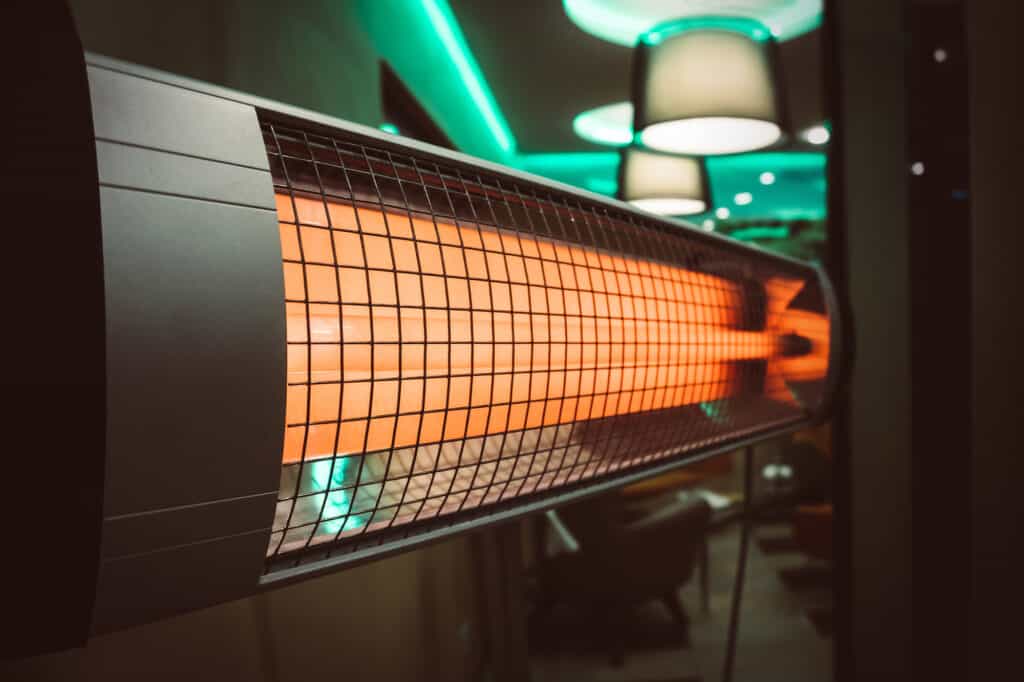Halogen vs. infrared heaters. Halogen heaters have a shortwave heating element that only heats a small area, requiring people to stand or sit close to the heater.
In contrast, infrared heaters emit electromagnetic waves that are absorbed by nearby people or furniture, providing more efficient and long-lasting heat.
Friends and family love to relax in patios and backyards, but what about using them during winter?
With numerous outdoor heating options, it can be hard to decide between halogen and infrared heaters.
Both types of heaters achieve the goal of generating heat. However, to make an informed decision, you may want to learn more about each type.
Keep reading for more information.

Related Reading: What Heaters Are Safe to Leave on Overnight? [ANSWERED]
Table of Contents
What Is a Halogen Heater?
Halogen heaters use halogen lamps or bulbs for heating, but the actual heating element is not the halogen element itself. The name can be misleading.
Halogen lamps use halogen gas to increase bulb brightness and lifespan. The gas prevents darkening and allows for safe use at higher temperatures compared to non-halogen heaters.
The halogen heater derives its name from using halogen bulbs, which produce both light and heat. One of its distinguishing features is the brightness emitted from the front.
Benefits of Using Halogen vs. Infrared Heaters
There are several advantages to using a halogen heater as opposed to other heaters.
- They save energy. A halogen heater produces radiant heat that can quickly warm small areas, reducing energy consumption.
- They are environmentally friendly. Halogen heaters operate without using fossil fuels, producing no smoke emissions and minimal carbon dioxide release.
- They are safe. The halogen lamps do not produce heat themselves, making them safe. They are cool to the touch and have an auto shut-off option in case of accidental tipping, making them ideal for homes with children or pets.
- They are easily installed in any outdoor area. Halogen heaters are easier to install than gas-powered heaters because they do not require the installation or replacement of electrical coils as the heater is used.
Disadvantages of Using a Halogen Heater
Just like most types of heaters, there are a few disadvantages to using halogen vs. infrared heaters.
- Not ideal for space heating. Halogen heaters are effective for providing radiant heat, but they are unsuitable for space heating in large areas and buildings.
- Costly to run. Halogen heaters can be expensive to operate, especially during the winter months when they are used for extended periods.
- Will only heat a specific area. A halogen heater only heats a specific targeted area. If someone stands or sits slightly outside this area, they will feel cold as it doesn’t heat that space.
What Is an Infrared Heater?
An infrared heater, also known as a heat lamp, works similarly to the sun in how it warms us when we stand under its rays.
Just like the invisible infrared light emitted by the sun, an infrared heater emits light that our skin absorbs, warming us up. This is similar to standing in the sunlight versus standing in the shade.
An infrared heater emits infrared light which is absorbed by you and objects in the room. Coils and a reflector direct the light outward. Your body absorbs the light which heats it up.
Benefits of Using an Infrared Heater
There are several benefits to using an infrared heater as a heat source.
- They Are Quiet. These heaters use light to heat, making them quieter than regular heaters without a fan. This makes them ideal for use in a bedroom at night.
- They Are Environmentally Friendly. Infrared heaters are a clean source as they don’t release pollutants or use fossil fuels or wood for heat production.
- They Give Off Instant Heat: As soon as an infrared heater is switched on, it emits light that generates heat. They warm objects and bodies, providing quick warmth.
- They Are Efficient: With this type of heater, there is little to no wasted heat since it only heats the bodies and objects it is directed at, rather than whole rooms or areas.
Disadvantages of Using an Infrared Heater
Although there are several different benefits to using an infrared heater, there can also be a few disadvantages.
- No Heat When Turned Off. When turned off, infrared heaters stop emitting light and quickly lose the heat they are producing, causing an abrupt temperature change.
- Light-Emitting. Infrared heaters emit an orange glow of varying brightness, which some may find bothersome.
- Limited Warmth Distribution. Infrared heaters are only effective for heating objects in their direct line of sight, making them unsuitable for larger spaces or rooms with frequent movement.
Common Misconception
When researching infrared heaters, be cautious of false claims that they can raise humidity levels and eliminate the need for a humidifier.
Using an infrared heater instead of central heating can prevent air from drying out quickly. However, it cannot replace a humidifier for increasing humidity levels.
Continue Reading: Understanding Patio Heater Electricity Usage: How Expensive Are They?
Conclusion
Halogen vs. infrared heaters; both heat a room, but they do so differently.
The size of the space and its use, as well as the efficient operation of the heater, may be considered before purchasing either heater.
For larger areas, you would need something more powerful such as a high-wattage electric heater. A gas heater can be an option, but only for outdoor, well-ventilated areas.
Whether you want a very efficient infrared heater or an ultra-safe halogen heater, both can provide the heat source you need.
This guide will help you choose which one is best for your needs.
Enjoy living the outdoor life!!!
